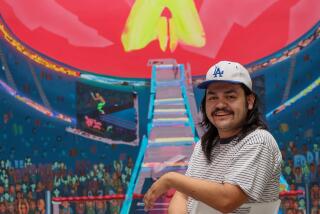Adam Mansbach’s ‘Rage is Back’ dips into the graffiti life
- Share via
Rage is Back
A Novel
Adam Mansbach
Viking: 304 pp., $26.95
“I always had this sense that there was a great American graffiti novel waiting to be written,” Adam Mansbach says.
Best known as the author of the bestselling, foul-mouthed “children’s book for adults” “Go the F— to Sleep,” Mansbach has penned an ambitious new novel. “Rage is Back” is a loving homage to graffiti culture in New York City.
Graffiti has been celebrated in art books and documentaries and canonized in recent shows like MOCA’s “Art in the Streets” exhibition, but few long works of fiction exist. With “Rage is Back,” Mansbach aims to change all that.
“I’m very interested in thinking about hip-hop aesthetics on the page,” Mansbach says. “What does a literature of hip-hop look like?”
Mansbach has an East Coast swagger to him, a refreshing in-your-face directness. Over a tall glass of coffee at a Berkeley cafe, he speaks as fluidly as he writes — peppering his language liberally with slang, cracking jokes, layering in references ranging from Homer to Jay-Z.
“There are more curses in [‘Rage is Back’] than there are in ‘Go the F— to Sleep,’” he jokes.
It’s hard to escape talking about the over-the-top success of his satire of a bedtime book, which made its debut at No. 1 on the New York Times bestseller list in 2011. “Go the F— to Sleep,” which started as a joke on Facebook, was an overnight viral marketing sensation. The book’s small indie publisher, Akashic Books, circulated advance PDFs instead of conventional galleys, which traded hands so many times that the book hit No. 1 on Amazon’s bestseller list months before it was even published.
Mansbach’s previous novels, including “Angry Black White Boy” and “The End of the Jews,” were critically acclaimed, but “Go the F— to Sleep” became a bona fide cultural touchstone, attracting high-profile fans ranging from Samuel L. Jackson (who read the audio book version) to Werner Herzog.
“Rage is Back,” meanwhile, is a 290-page novel that took nearly three years, on and off, to write — a successor, he says, to “The End of the Jews.” It revolves around Dondi Vance, a smart, conflicted Brooklyn teenager whose parents were old-school graffiti legends.
It’s 2005, and Dondi is sick of hearing about the glory days of graffiti; his deadbeat dad, Billy Rage, has been on the run from the law for 16 years. To him, New York in the 1970s and ‘80s is old-man stuff.
“I spent my childhood surrounded by grown… men who still call themselves Donk 202 and Blaze One…arguing about who kinged the 2 [subway trains] in ’76 and who rocked the Flying Eyeball character first, Kid Panama or Seen,” Dondi says in the book. “I know more about nostalgia than anybody my age should, man.”
Dondi is wise beyond his years — wiser, perhaps, than the complicated adults who surround him. When Dondi’s father suddenly bursts into Dondi’s life, he unleashes a wild wave of chaos, adventure and soul-searching.
For Mansbach, “Rage is Back” strikes a deeply personal chord. “Dondi’s voice really flowed for me,” he says. Mansbach spent his formative years in New York City, immersing himself in hip-hop culture and founding a hip-hop magazine called Elementary.
“I was primarily an MC and a DJ, but I also wrote graffiti and I hung out with a lot of graffiti writers,” Mansbach says. “I was never particularly good. I was a good MC, I was a good DJ, but graffiti — the hand styles — it wasn’t my thing. So I kind of demoted myself to [the role of] lookout pretty quickly.”
For 20 years, he says, he’s been befriending graffiti writers, talking to them about their history.
“I think I pretty quickly figured out that graffiti writers were the geniuses, the eccentrics, the mad scientists of hip-hop — you know, the weirdos,” he says. “I liked to hang out with them.”
For these friends, graffiti’s story in New York was a tale of richness and despair.
“There was this very weird sense of these [graffiti writers] who had outlived what they had created,” Mansbach says.
“The thing they had created by that time was worldwide,” he says, made famous by movies like the 1983 documentary “Style Wars” and the notoriety of subway art. “But here were these guys who were legendary, who were being sweated all over the place, but they couldn’t make a living.”
Many of these graffiti writers, Mansbach says, started living in the past, swapping stories about the glory days of New York graffiti art.
By the late 1980s, large-scale graffiti art on the New York City subways was in its death throes. The city destroyed untold amounts of art in its relentless quest to erase graffiti. In “Rage is Back,” the character Anastacio Bracken, a villainous MTA police chief turned mayoral candidate, hell-bent on quashing graffiti writers forever, embodies the “vandal squad,” the real-life New York City transit police who warred against graffiti writers.
“A lot of these guys are obsessed,” Mansbach says. “There are retired vandal squad cops today writing books about chasing these kids around the tunnels. They can’t let go of it any more than the writers can.”
“Rage is Back” tries to encapsulate graffiti’s complexities, its contradictions and its triumphs, and the romance of its wayward heroes.
Graffiti writers, Mansbach says with a laugh, are “very compromised superheroes.”
Dayal is an arts journalist based in San Francisco.
More to Read
Sign up for our Book Club newsletter
Get the latest news, events and more from the Los Angeles Times Book Club, and help us get L.A. reading and talking.
You may occasionally receive promotional content from the Los Angeles Times.








